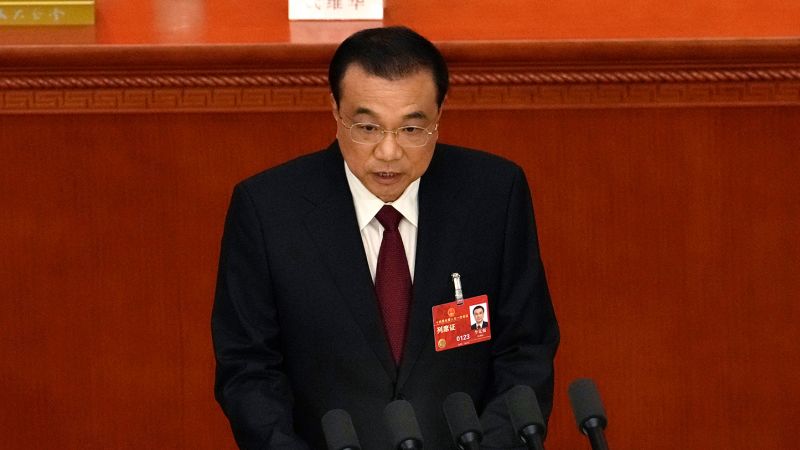China sets lowest GDP growth target in decades as Beijing tightens its belt | CNN Business
Hong Kong
CNN
—
China’s outgoing Premier Li Keqiang has announced the country’s lowest GDP growth target in decades, highlighting the domestic and global challenges the world’s second largest economy still faces despite its decision late last year to ditch draconian anti-Covid measures.
Li set a target of about 5% growth for 2023 during the National People’s Congress on Sunday, while acknowledging the “many difficulties” the economy is facing. The only year in recent history when the government has been less ambitious was in 2020, when it passed on a numerical target because the economy was nearly paralyzed by the initial Covid outbreak.
“Insufficient demand is still a prominent issue,” Li said Sunday. “Stabilizing employment is tough. And some local governments face big fiscal difficulties.”
Perceived as marginalized by Chinese leader Xi Jinping in recent years, Li will be formally stepping down during the congress as part of the biggest shake-up to the country’s economic leadership in a decade.
Li is likely to be departing along with a generation of Western educated, reform-minded officials who have influenced economic policy making over the past 10 years. The new team, tipped to be composed of Xi’s close associates, faces the tough task of reviving the economy.
China is in the midst of a historic downturn for the all-important housing market. Consumer spending is sluggish. Unemployment remains high among the youth.
Business confidence has plummeted following an unprecedented regulatory crackdown on the private sector and increased uncertainties about China’s future policy. Relations between the United States and China are at their lowest point in decades, leading to escalating tensions in technology and investment. Foreign investment in China has slumped.
In a message rarely heard from top officials, Li hinted in his address to the nation at rising public discontent about the government, calling on the country’s policymakers to “face up to the issues and do its best to improve the government’s work.”
Mass protests erupted late last year across the country, in a rare show of dissent against the ruling Communist Party sparked by anger over its zero-Covid policy. Last month, protests occurred in the central city of Wuhan and northeastern city of Dalian as hundreds of elderly confronted local officials to oppose changes to their health insurance, which had cut their medical benefits significantly.
Nomura analysts said the 5% growth target suggests “the government is conservative but pragmatic about the economic prospects in 2023, with weakening global demand taking a toll on exports, worsening geopolitical tensions and a still-moderate recovery in the housing sector.”
The new State Council, China’s cabinet, is also “taking a lesson” from the substantial miss in growth target last year, they added.
In 2022, the Chinese economy grew by 3%, the second lowest growth in nearly half a century and behind only 2020. It fell well short of the official growth target of “around 5.5%.”
“Having declared the end of pandemic, the leaders are sticking to the slowing GDP growth path in the long term by lowering annual GDP target gradually,” said Ken Cheung, chief Asian foreign exchange strategist at Mizuho Bank.
“Moreover, China has been downplaying the numeric GDP target and shifted to balance the quality since President Xi’s era,” he said.
In Li’s final report on the work of the government, he called for expanding consumption and set a goal to create around 12 million jobs in towns and cities this year, up from last year’s target of at least 11 million.
Beijing will also allow local governments to issue up to 3.8 trillion yuan ($550 billion) in special bonds in 2023, which will help them build 5G networks, railways, airports and other infrastructure projects, Li added.
But that is lower than last year’s quota of 4.15 trillion yuan ($600 billion) and below market expectations.
The lower target suggests infrastructure growth will slow this year, said Iris Pang, chief economist for Greater China at ING Group.
The government’s fiscal deficit last year was too high, at 8% to 9% per GDP, which has likely reduced its firepower to fund more infrastructure spending, she explained.
Premier Li also said the government would only raise fiscal spending by 5.6% this year, which is lower than the growth of 6.1% in fiscal spending in 2022.
According to the finance ministry’s latest budget report, local government revenue is expected to grow by only 0.4% this year, an indication of Beijing’s conservative forecast on land sales.
Local governments have relied heavily on land sales in the past as a source of revenue but those receipts contracted by 23% in 2022, dealing a blow to finances already strained by huge Covid spending.
“After three years of pandemic [measures], it could be more than desirable for governments, especially the local governments, to restore fiscal resilience,” said Citi analysts.
“Eyeing … fiscal repair and aware of inflation risks, the government work report provides no hint [of] massive fiscal or monetary stimulus,” they said.
Earlier this month, Liu Guoqiang, a deputy governor at the People’s Bank of China, said the economy needs more policy support, but the central bank will not resort to “flood-like” stimulus measures as it seeks to strike a balance between boosting growth and ensuring price stability.




